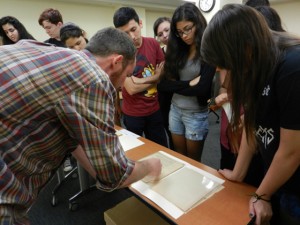
Some high school students spend their summer vacations soaking up the sun or playing computer games. But Houston-area students enrolled in the Wonderworks academic enrichment program spend five weeks of their summer intensively studying art, architecture, film, or literature. In early July, Wonderworks students in a class called Story Lines visited Special Collections to get up close and personal with one of author Larry McMurtry’s manuscripts.
The students had already read McMurtry’s novel The Last Picture Show, a coming-of-age story set in a small Texas town, and viewed the classic film of the same name. But their instructors Zachary Martin and Daniel Wallace, PhD students in the Creative Writing Program at the University of Houston, also wanted them to see first-hand the process McMurtry used in shaping his novel.
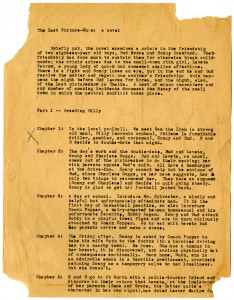
Larry McMurtry’s typed notes and outline for The Last Picture Show (from the Larry McMurtry Papers)
Students examined the original typewritten first draft, noting McMurtry’s handwritten word changes and replacements of characters’ names. (Would the beautiful Jaycee have been as alluring if she were still named Lavetta?) Martin led the class through a typed outline of the plot points McMurtry originally intended his story to follow, encouraging them to identify which ones stayed in the novel and which ones were discarded by the author.
Martin used McMurtry’s draft as a springboard to talk to the students about their own writing, and the necessity of building up their prose and ruthlessly editing it into something stronger. Perhaps viewing the original words of one Houston-related writer has inspired the next generation of Houston writers.
To be inspired yourself, please visit the Special Collections reading room Our summer hours are Monday – Friday, 9:00 a.m. to 5:00 p.m.
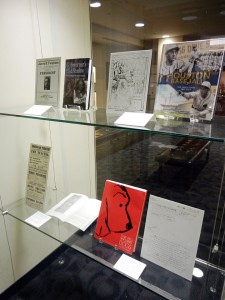
a new rotating, mini-exhibition of publications and projects produced in conjunction with research from the University of Houston Special Collections is now on display
The University of Houston Special Collections has begun a rotating exhibition showcasing highlights of publications and projects produced in conjunction with research from our collections. Located in the exhibit space adjacent to the Special Collections front door, in the Aristotle J. Economon, Hanneke Faber & Andrew J. Economon Elevator Lobby, “From Our Collections… Publications & Projects Featuring Research from the UH Libraries’ Special Collections,” shines a light on the fruits of research gathered from the rare books and archival collections preserved, safeguarded, and made available for study at the University of Houston.
With more than 7,000 linear feet of archival collections and over 100,000 rare books, the UH Special Collections provides daily research assistance to authors, filmmakers, artists, and patrons of all varieties. What they produce and share with us, enlightens, often breaks new ground, and rarely fails to astound.
Works and research currently featured include:
In the Governor’s Shadow: The True Story of Ma and Pa Ferguson, Carol O’Keefe Wilson (2014); featuring research from the Claude Elliott Texana Collection.
Houston Baseball: The Early Years 1861-1961, Mike Vance, editor (2014); featuring research from the George Fuermann “Texas and Houston” Collection and Houstonian Yearbooks.
“‘For the Relief of the Texians’: A Theatrical Benefit to Aid the Texas Revolution,” Pat Bozeman (2012); from Southwestern Historical Quarterly, featuring research from the Governor James V. Allred Papers.
The Big New Yorker Book of Dogs, The New Yorker Magazine (2012); featuring the short story “Chablis” by Donald Barthelme and research from the Donald Barthelme Literary Papers.
In addition to this new mini-exhibit, we pass along a gentle reminder to catch “LGBTQI Literature: Celebrated Classics and Contemporary Works,” currently viewing on the first floor of the M.D. Anderson Library. We hope you enjoy both of these exhibitions and look forward to sharing more in the future.
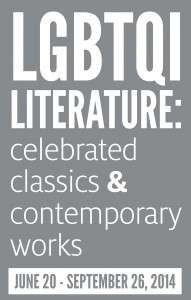
a new exhibit, “LGBTQI Literature: Celebrated Classics and Contemporary Works,” is now on display on the first floor of the M.D. Anderson Library
A new exhibit has opened on the first floor of the M.D. Anderson Library. “LGBTQI Literature: Celebrated Classics and Contemporary Works,” curated by our own Julie Grob, features fiction, poetry, memoirs, and plays written by and about people who are lesbian, gay, bisexual, transgender, queer, or intersex. Opening now to coincide with the annual Pride Houston celebrations, the exhibit serves as an excellent educational complement to the festivities marking historical milestones in the movement.
Tracing critical and popular literature from those days prior to Stonewall, the years following the so-called riots, through the dark days of the AIDS crisis, and on into contemporary pieces produced at the turn of the new century, “LGBTQI Literature” pulls from a number of distinct libraries available for study and research at the University of Houston Special Collections as well as a handful of pieces on loan from private collections. Prominently featured throughout the exhibit are texts from the Norma J. Lee Collection and the Edward Lukasek Gay Studies Collection, as well as works found in the Library of Cynthia Macdonald and the Kanellos Latino Literary Movement Book Collection. A cursory glance of highlights will show the likes of a 1928 first edition of Virginia Woolf’s Orlando: A Biography, Tony Kushner’s ever-popular Angels in America: A Gay Fantasia on National Themes, as well as an 1891 printing of Oscar Wilde’s, The Picture of Dorian Gray.
We invite you to come view the exhibit for yourself, explore the exhibit’s website for more information, or stop by the History Tent on June 28th at the Houston Pride Festival and Parade where our own Vince Lee, Archivist for Carey C. Shuart Women’s Archive and Research Collection, will be in attendance with more information and artifacts on display.
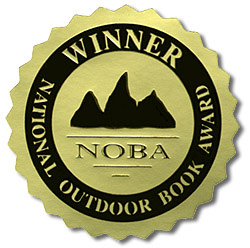 The University of Houston Special Collections congratulates Gail Storey as her memoir, I Promise Not to Suffer, receives the National Outdoor Book Award for Outdoor Literature.
The University of Houston Special Collections congratulates Gail Storey as her memoir, I Promise Not to Suffer, receives the National Outdoor Book Award for Outdoor Literature.
I Promise Not to Suffer: A Fool For Love Hikes the Pacific Crest Trail (Mountaineers Books) recounts the trials and travails faced by Gail and her husband, Dr. Porter Storey, as they trek the 2,663 miles of the Pacific Crest, meeting mountain lions and movie star dogs along the way. This tale of a reluctant hiker and camper, embarking on an odyssey of beauty and anxiety, has been lauded by critics as witty, wrenching, smart, and, not to mention, hilarious.
Describing the sublime beauty and transformative experience in her prose she writes, “Even as my body wore down, my heart opened. Like the snow plant, bursting red through the forest floor. Because of the mountains, the blue space of sky, the softness of green on gray rocks splashed with lichens? Or back in the desert, when colors took the place of thoughts: blue-purple lupines, creamy white yucca, prickly poppy yellow? Now, pearlescent cool air soothed my forehead and my mind settled down.”
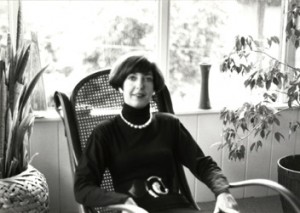
Gail Storey (1992). Photo by Marion Barthelme, from the Gail Donohue Storey Papers.
The author of The Lord’s Motel and God’s Country Club, Storey’s connection to Houston goes back to the early 1980s when she worked for and earned her MA from the prestigious English and Creative Writing program at the University of Houston. Here at Special Collections we are proud to celebrate that connecting thread of Storey’s writing and career as we make available for study the Gail Donohue Storey Papers, a part of our Contemporary Literature collections.
For those interested in learning more about Gail Storey and her writings, be sure to check out her website, the recent interviews with New Dimensions Radio and Colorado Public Library, or visit the Special Collections Reading Room to take a deeper and longer look at the Gail Donohue Storey Papers.
Finding Aid for the Cynthia Macdonald Papers Now Available Online
What does it mean to live the Writer’s Life? We often hold to the stereotype of the solitary writer, alone among her books in a cramped apartment above a laundromat or a Greek restaurant, hammering away at the keyboard (or better yet: typewriter) to the strains of the city outside her window, the cacophony of sirens and taxicabs and nightclub jazz and the whistle and scream of anguished souls on the streets below. Or the even more hermit-like author, tucked away in a mountain cabin, sitting in a rocking chair he carved himself while ruminating on the beautiful mysteries of Mother Nature and the folly of humankind.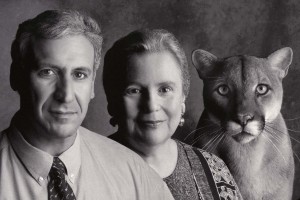
But there is another way, and Cynthia Macdonald, co-founder of the UH Creative Writing Program, has lived it. The Writer’s Life can be one that is fully engaged with the world around her. The writer can laugh and cry and struggle and celebrate with an unrelenting vigor. The writer can draw people into her orbit; can follow her curiosity down myriad paths to become an eclectic expert; can live firmly on the ground in the real world and turn its drudgeries and heartbreaks and ecstasies into Art.
The finding aid for the Cynthia Macdonald Papers is now available online, and the collection is a treasure trove for researchers, writing students, fans of Macdonald’s poetry, and anyone interested in seeing how a writer makes a go of it in this world.
Special Collections houses more than 45 boxes of Cynthia Macdonald’s work and personal materials. The collection includes multiple drafts of her 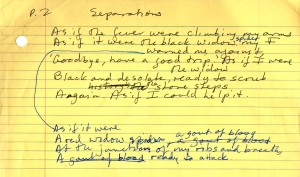 poems, both published and unpublished, both typed and handwritten, from scrawls on paper napkins and backs of envelopes to fully polished manuscripts. In addition to Macdonald’s writings, the collection also highlights the business and publicity surrounding a modern writer: contracts and royalty statements; writing proposals, grants, and awards; news clippings, book reviews, and poetry readings.
poems, both published and unpublished, both typed and handwritten, from scrawls on paper napkins and backs of envelopes to fully polished manuscripts. In addition to Macdonald’s writings, the collection also highlights the business and publicity surrounding a modern writer: contracts and royalty statements; writing proposals, grants, and awards; news clippings, book reviews, and poetry readings.
The abundance of correspondence is especially rich, featuring letters to and from Macdonald’s writing friends, teaching colleagues, and family members. Among the many noteworthy contributors are famous poets and writers such as Louise Erdrich, James Michener, Adrienne Rich, and Anne Sexton, as well as artists in other fields such as painter Helen Frankenthaler, photographer Gay Block, and singer Judy Collins.
The collection also provides a window into Macdonald’s long career as co-founder and teacher at UH’s acclaimed Creative Writing Program; her early, budding career as an opera singer; and her later, successful career as a professional psychoanalyst. The diligent researcher can also piece together other aspects of Macdonald’s life from a vast array of personal and family mementos and photographs, collected over almost the entire course of her life, from early childhood onward.
For more information about what is contained in the collection, be sure to take a look at the detailed finding aid. The original materials can be viewed in the Special Collections Reading Room.
So, what does it mean to live the Writer’s Life – or any life, for that matter? One way is to hunker down, hole up, and protect one’s writing and one’s heart in the safety of one’s own company, alone, but safe, but alone. Another way, though, as Cynthia Macdonald has demonstrated, is to reach out for all of life, to embrace life fiercely and expressly, to share bravely our thoughts and opinions and hearts with others, to write and live and write again and live some more, to dare to engage every aspect of the world around us, opening ourselves to the possibility of pain, yes, but to that of love as well.
